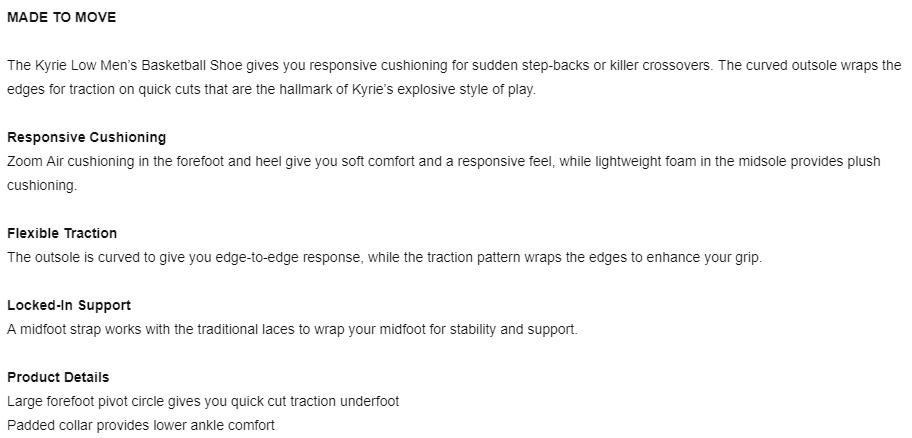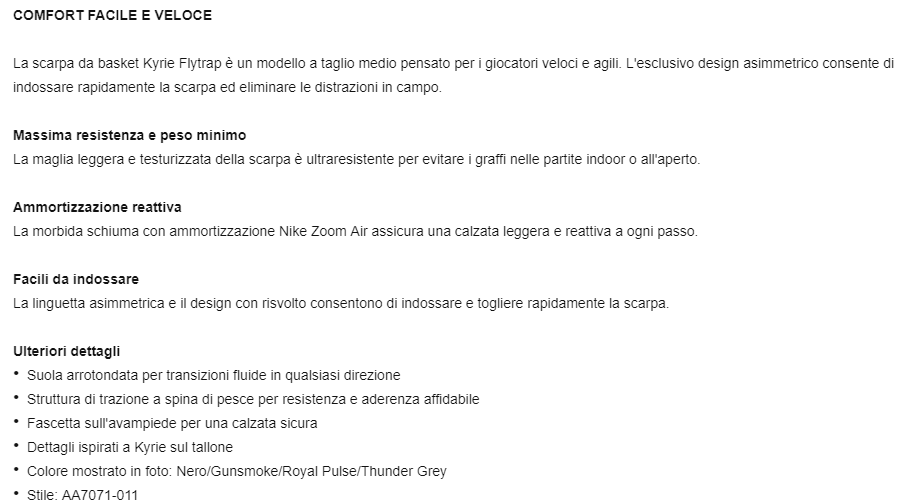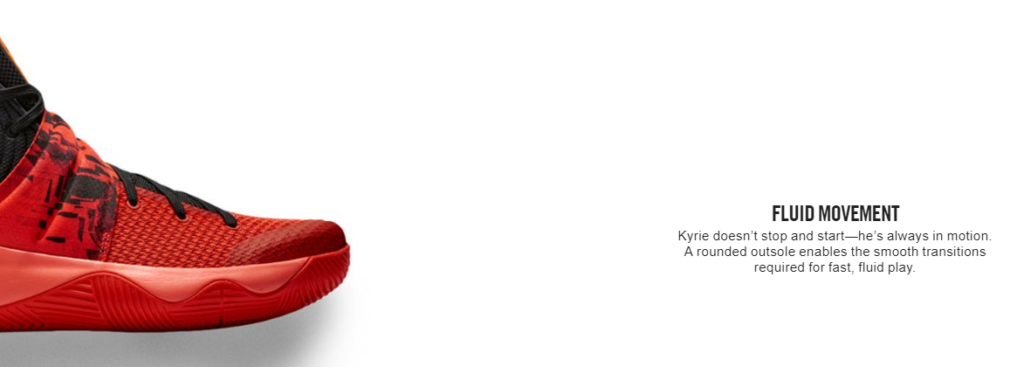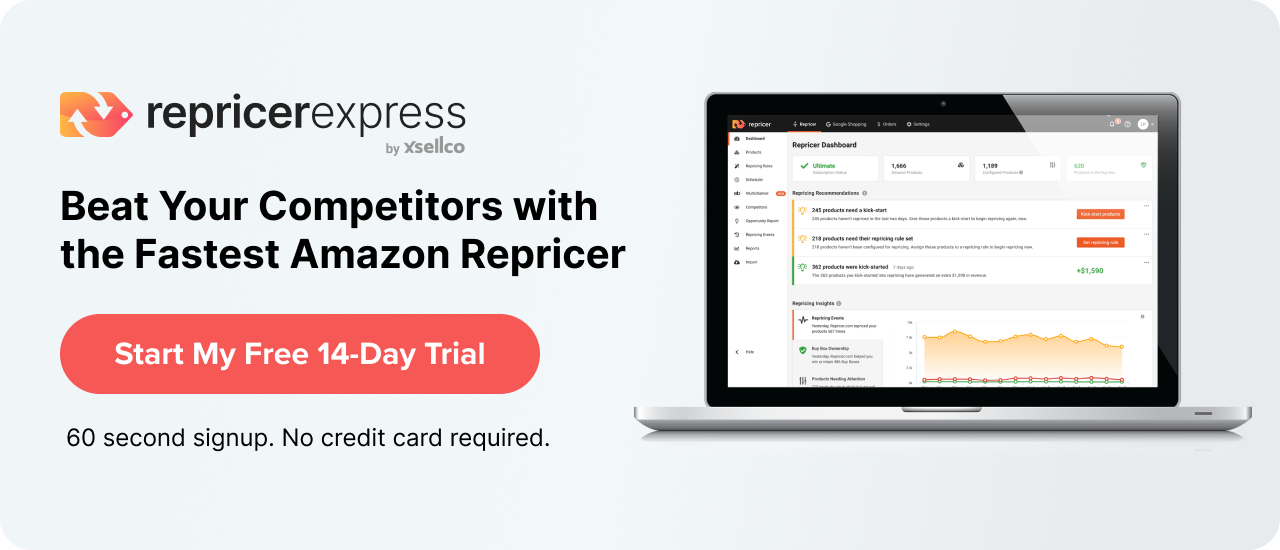Have you ever read a product description that made you want that product right away? I certainly have. Being a huge fan of basketball, I often visit Nike’s website to look for new gear. One day I made a usual visit and got so excited I almost jumped out of my pants when I read the description of Kyrie Irving 2 shoes.
Whoever wrote that description is a genius because I bought those shoes the same day. And the best thing about that description was that it wasn’t a description. It was a story. It was an explanation. It was an introduction to an amazing world of basketball.
Of course, writing such things is easier said than because the enthusiasm alone doesn’t make sales. One needs to have a deep knowledge of the product as well as the story behind it to turn it into a must-have.
In an attempt to help you write ecommerce product descriptions like Nike, I’ve created a list of key aspects and tips that you should know about.
1. Know Who’s Buying Your Products
If you write a product description without knowing your target reader, chances are it’ll be aimless and vague. Many writers make a mistake by trying to target anyone and everyone, but you have to overcome this temptation and consider only your ideal buyer.
But who’s your ideal buyer? That, my dear friends, is something that you’ll need to find out by using your own research. One good way to do it right is to use buyer persona.
According to the Content Marketing Institute, a buyer persona is “a composite sketch of a target market based on validated commonalities – not assumptions – that informs content strategy.”
A complete picture of your ideal buyer should include the following parts (recommended by the Content Marketing Institute):
- A typical day in the life of the buyer.
- His/her objectives and goals in both professional and personal life (“get 500 more subscribers to my blog” etc.).
- His/her problems and issues (“my blog doesn’t have enough subscribers” etc.).
- His/her orientation towards their job (“Mark has been in advertising for 10 years, so we need to write in a confident, authoritative style”).
- Their relevant obstacles in both personal and professional life (“How to do write excellent product descriptions so my business sells more?” etc.).
- Their burning questions (How to resolve X to get Y? etc.).
- Their content preferences (images, how-to articles, etc.).
- Keywords and keyword phrases that the person would use to search for your products and services (“how to write excellent product descriptions for small businesses” etc.).
- Engagement scenarios that visualise how the persona might want to interact with the information from the previous parts strategically.
2. Nail Features and Benefits
Yes, a great product description is much more than a description, but you still have to list the features. To make them as interesting as possible to the viewers, you use a popular technique of transforming a feature into a benefit.
Simply explained, each sentence of your description should answer the question “So what?”.
Take a look at the following description of another product from Kyrie Irving line, written by Nike:

Let’s take a couple of paragraphs to demonstrate how the writer nailed the benefits.
Responsive Cushioning
Zoom Air cushioning in the forefoot and heel give you soft comfort and a responsive feel, while lightweight foam in the midsole provides plush cushioning.
Flexible Traction
The outsole is curved to give you edge-to-edge response, while the traction pattern wraps the edges to enhance your grip.
The parts highlighted in bold represent excellent examples of how the “So what?” question should be answered in a product description.
Tessa Brown, a copywriter at ResumesCentre says: “Writing excellent descriptions requires a certain level of skills and expertise. Finding skilled writers who can produce descriptions like that can a challenge for ecommerce businesses.”
Another thing that I should mention here is the importance of an accurate translation. Nike, for example, has a number of websites in different languages, so they hire experienced translators to ensure that the benefits to the customers are correctly and appropriately translated for local audiences.

3. Choose an Appropriate Voice
In addition to the details, the tone of the voice of the description should be appropriate for your target audience. But how can you talk to them? The choice ultimately depends on the outcome of your buyer persona research.
Let’s continue with excellent examples from Nike. A basketball fan like me knows very well that Kyrie Irving is an NBA superstar who is known for his amazing crossovers and quick moves. Of course, Nike will tailor the description of Irving’s line to people like me, interested in great basketball shoes.
Take a look at the description of the shoes I’ve mentioned in the introduction (it’s actually one of the sections of the description taken from the product page):

Why it’s good?
- The tone is casual, which is appropriate for Nike’s target audience.
- The writer knows that the viewers are familiar with Irving’s style of play, so they make a specific emphasis on that and reveal how it inspired the design of the product.
- The heading of this section highlights the benefits to the customers.
4. Always Proofread
Would you be interested in buying a product the description of which contains grammatical mistakes? I wouldn’t because the only thing that description tells me is that the business doesn’t care enough for its customers to proofread the text.
Remember: all product descriptions on your website should be polished and perfect to sell more. They can easily ruin your image as a brand and create other problems, so proofread your content ruthlessly.
If you’re not sure if you did well, don’t hesitate to collaborate with copywriters and content writers who can help you to both write compelling copies and proofread them. The list of suitable online tools that offer machine and human proofreading and editing includes Grammarly and Writer.
5. Choose your Bullet Points Carefully
Many people think that product images and reviews are the most important features of product pages, but I always add bullet points to this list as well. They are a great way of avoiding large chunks of text and provide the most relevant information.
For example, let’s take a look at another Nike’s product description that uses a bullet list.
This bulleted list is good because:
- The points are short and sweet.
- The points are scannable.
- The points describe easy-to-understand product features.
- The points describe the features as well as their benefits to the customer.
- The points support the description above them.
6. Time to Write!
Do you want to have the same effect on your customers as Nike had on me? Well, then feel free to apply the tips from this article to create product descriptions for your own eCommerce website. And remember, enthusiasm alone doesn’t make sales, so to get your customers excited and educated about your products, you have to apply some knowledge and write descriptions that even get Nike’s writers interested.
Automate your Amazon Pricing
Once you’ve got your Amazon descriptions optimised using the tips above, it’s time to focus on your Amazon pricing strategy. Fancy winning more Buy Box at a higher margin? Join thousands of happy Amazon seller today with your free 14-day trial of Repricer Amazon Repricing Software.






